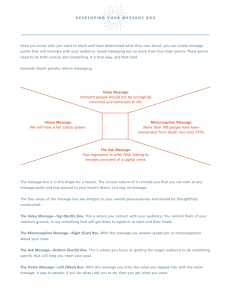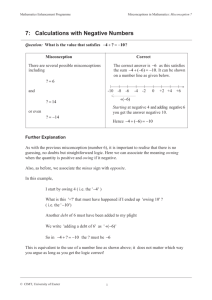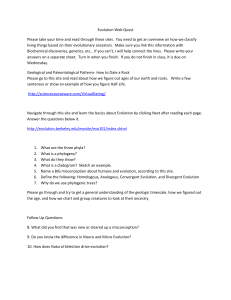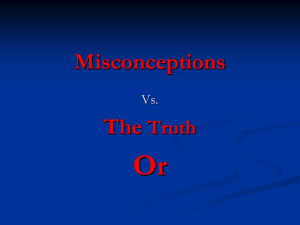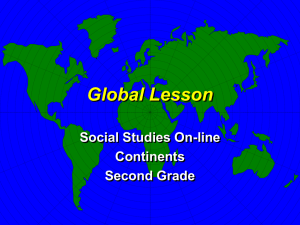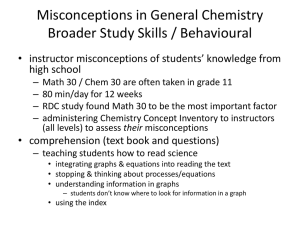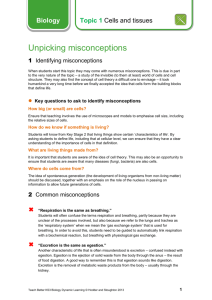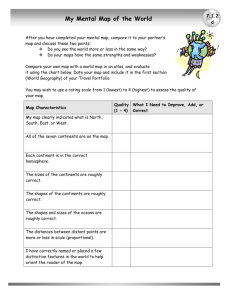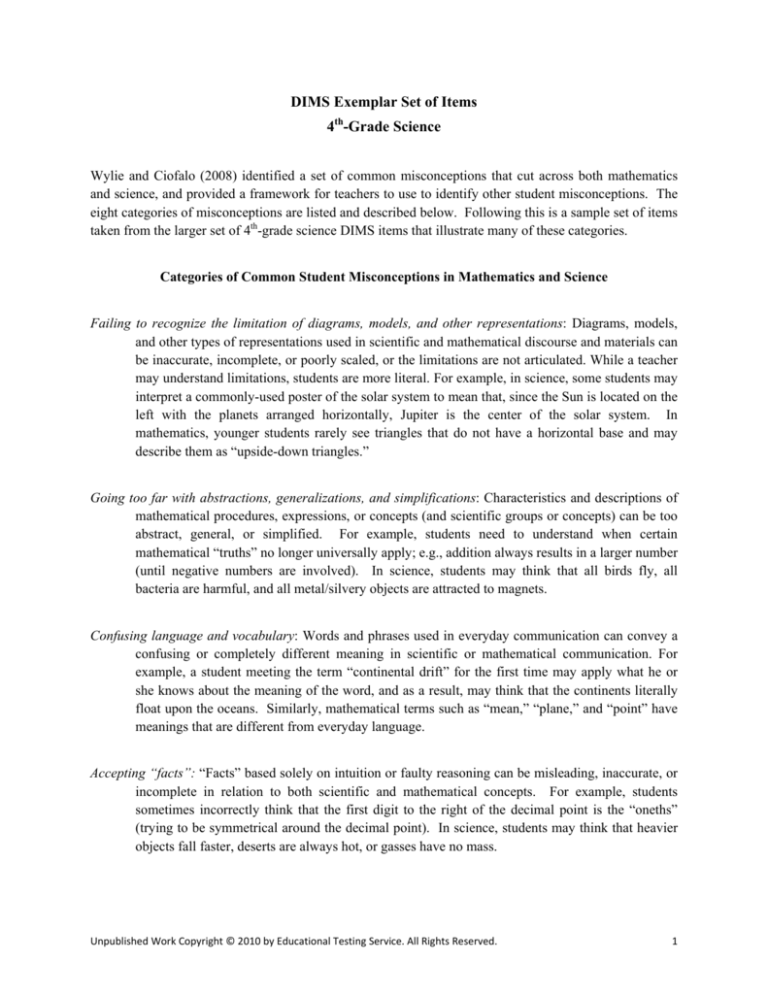
DIMS Exemplar Set of Items
4th-Grade Science
Wylie and Ciofalo (2008) identified a set of common misconceptions that cut across both mathematics
and science, and provided a framework for teachers to use to identify other student misconceptions. The
eight categories of misconceptions are listed and described below. Following this is a sample set of items
taken from the larger set of 4th-grade science DIMS items that illustrate many of these categories.
Categories of Common Student Misconceptions in Mathematics and Science
Failing to recognize the limitation of diagrams, models, and other representations: Diagrams, models,
and other types of representations used in scientific and mathematical discourse and materials can
be inaccurate, incomplete, or poorly scaled, or the limitations are not articulated. While a teacher
may understand limitations, students are more literal. For example, in science, some students may
interpret a commonly-used poster of the solar system to mean that, since the Sun is located on the
left with the planets arranged horizontally, Jupiter is the center of the solar system. In
mathematics, younger students rarely see triangles that do not have a horizontal base and may
describe them as “upside-down triangles.”
Going too far with abstractions, generalizations, and simplifications: Characteristics and descriptions of
mathematical procedures, expressions, or concepts (and scientific groups or concepts) can be too
abstract, general, or simplified. For example, students need to understand when certain
mathematical “truths” no longer universally apply; e.g., addition always results in a larger number
(until negative numbers are involved). In science, students may think that all birds fly, all
bacteria are harmful, and all metal/silvery objects are attracted to magnets.
Confusing language and vocabulary: Words and phrases used in everyday communication can convey a
confusing or completely different meaning in scientific or mathematical communication. For
example, a student meeting the term “continental drift” for the first time may apply what he or
she knows about the meaning of the word, and as a result, may think that the continents literally
float upon the oceans. Similarly, mathematical terms such as “mean,” “plane,” and “point” have
meanings that are different from everyday language.
Accepting “facts”: “Facts” based solely on intuition or faulty reasoning can be misleading, inaccurate, or
incomplete in relation to both scientific and mathematical concepts. For example, students
sometimes incorrectly think that the first digit to the right of the decimal point is the “oneths”
(trying to be symmetrical around the decimal point). In science, students may think that heavier
objects fall faster, deserts are always hot, or gasses have no mass.
Unpublished Work Copyright © 2010 by Educational Testing Service. All Rights Reserved. 1 Applying real-world experiences and perceptions which can contradict scientific learning: Everyday life
and perceptual experiences can be misleading, inaccurate, or incomplete in relation to various
scientific explorations, studies, or concepts. For example, the five human senses seem infallible
to young students, yet human vision differs from certain insects that see in the UV portion of the
spectrum; it is hard to believe that sounds exist that humans cannot hear; touch is deceptive and
so wood feels “warmer” than metal in same room.
Accepting common sayings, beliefs, and myths: Widely heard/communicated sayings, beliefs, or myths
can be misleading, inaccurate, or incomplete in relation to various scientific explorations, studies,
or concepts. For example, some students believe that humans coexisted with/killed the dinosaurs;
meteors are “falling stars,” and camels store water in their humps.
Applying metaphors and analogies that only partially explain a scientific concept: Metaphors and
analogous comparisons of scientific objects or concepts with everyday terms can be misleading,
inaccurate, or incomplete in relation to various scientific concepts. For example, the following
analogies are partly helpful, but each has its limitations: electricity as water flowing; the heart as
a pump; the eye as a camera.
Accepting false equivalencies: Various mathematical procedures or concepts are sometimes viewed
incorrectly as being equivalent. For example, students may try to manipulate fractions using
whole-number reasoning, think that calculations involving time are the same as working with
decimals, or assume that subtraction and division are commutative, like addition and
multiplication.
About the Sample Set of Items Presented
Each item is presented along with the correct answer (answers) and the misconception category
(categories) that is (are) addressed. For relevant answer choices, a longer explanation is provided
regarding possible reasons that students may or may not select those choices. The explanations are tied to
the common misconceptions that certain students bring to the classroom every year, along with suggested
origins for those misconceptions. Also included are some caveats and suggestions for teachers to be
aware of and think about as they teach the various concepts, procedures, and investigations each year.
The items can be used as presented, or modified according to student needs. For example, an item could
be read to the class or students could be asked to read it; answer choices could be revealed one at a time
and students asked to think about each one; some answer choices could be removed (paying attention to
how answer choices correspond to potential misconceptions) to simplify the item; students could work
alone or in pairs, etc. The primary goal is to provide information that will be useful to inform next
instructional steps.
Unpublished Work Copyright © 2010 by Educational Testing Service. All Rights Reserved. 2 “The Center of the Solar System”
Science, Q4 – 47 – 07
Which of the following is the center of our solar
system?
(A) The Moon
(B) A point between the Sun and Earth
(C) The Sun
(D) Earth
(E) A point between Earth and the Moon
(F) Jupiter
DIMS: 4th grade Science
Correct answer:
Copyright (c) 2007 Educational Testing Service. All rights reserved.
(C) The Sun
Misconception categories: Real-World Experiences and Perceptions
Diagrams, Models, and Other Representations
This 4th-grade science question actually addresses two different types of misconceptions
regarding the center of our solar system.
(D) Earth. Students who select this answer choice are applying real-world experiences and
perceptions which can contradict scientific learning. These students observe the Sun and the
planets “moving” across the sky, and it is more intuitive or natural to assume that these
objects are moving around Earth rather than assume Earth is rotating. This observation
combined with a geocentric bias has led students and other people throughout the ages to
think that Earth is the center of the solar system, if not the universe.
(F) Jupiter. Students who select this answer choice are failing to recognize the limitations of
a diagram or model. While teachers may understand those limitations, students are often
more literal. A rather ubiquitous poster of the solar system shows the Sun on the left and all
planets lined up in a row to the right. Jupiter is placed in the central location on the poster.
Students who view this poster often assume that the planets all revolve around the Sun in a
straight line and/or that Jupiter is the center of the solar system.
Teachers are generally surprised to realize how graphic representations they have displayed
in their classrooms for years or that appear in textbooks and worksheets can often cause or
reinforce common student misconceptions.
Unpublished Work Copyright © 2010 by Educational Testing Service. All Rights Reserved. 3 “What is Magnetic?”
Science, Q4 – 32 – 01
Which of the following objects can be picked up with a
magnet?
(A) A silver-colored plastic pen
(B) An iron nail
(C) A nickel
(D) A quarter
(E) A copper wire
(F) A piece of aluminum
(G) A ring made of silver
DIMS: 4th grade Science
Correct answer:
Copyright (c) 2007 Educational Testing Service. All rights reserved.
(B) An iron nail
Misconception category: Abstractions, Generalizations, and Simplifications
This 4th-grade science question addresses two different misconceptions, both from the same
category, regarding magnetic objects.
(A) A silver-colored plastic pen. Students who select this answer choice are going too far
with a generalization. These students have observed, read about, or been told that magnets
attract objects generally made of iron (but also nickel and cobalt, as well as combinations of
these metals). Having seen a piece of iron which is often silver colored, they are making the
generalization that magnets attract all silver-colored objects, including a pen made only of
plastic.
(C) – (G), various metallic objects. Students who select these answer choices are also going
too far with a generalization. These students have observed, read about, or been told that
magnets attract objects made of iron. From this knowledge, they are making the
generalization that magnets attract objects made of any metal, including silver, aluminum,
and copper.
Teachers sometimes forget that students are continually attempting to make sense of the
world around them by looking for patterns. We expect this with young children learning to
talk, and so are not surprised when a child says, “I seed three mouses.” Although incorrect,
this shows that the child realizes that to indicate past tense of a verb often just add “–ed”
and to make a noun plural just add “–s.” Of course, looking for patterns does not suddenly
stop after early childhood, and can sometimes lead to incorrect conclusions.
Unpublished Work Copyright © 2010 by Educational Testing Service. All Rights Reserved. 4 “Moving Continents”
Science, Q4 – 33 – 05
Geologists say that the continents were closer
together millions of years ago. How can we explain
this?
(A) The continents are floating on the ocean, so they
drifted apart.
(B) Hot, liquid rock came to Earth's surface, pushing
the continents apart.
(C) Continents do not really move; it just looks like
they have moved.
DIMS: 4th grade Science
Correct answer:
Copyright (c) 2007 Educational Testing Service. All rights reserved.
(B) Hot, liquid rock came to Earth’s surface, pushing the
continents apart
Misconception category: Language and Vocabulary
This 4th-grade science question addresses two different misconceptions, both from the same
category, regarding the movement of continents.
(A) The continents are floating on the ocean, so they drifted apart. Students who select this
answer choice are confusing language and vocabulary. In this case, the word “drift” used in
everyday communication conveys a meaning that is confusing or different from its use in the
scientific concept of “continental drift.” Students have generally heard of continental drift
and think of something that is “drifting” as something that is freely floating on watery
currents or waves. Therefore, these students think that the continents have drifted apart
because they are floating on the ocean.
(C) Continents do not really move; it just looks like they have moved. Students who select
this answer choice are also confusing language and vocabulary. The word “move” used in
everyday communication conveys a meaning that is confusing or different from its use in this
scientific concept of continental movement. When something “moves,” it is generally fast
enough to be readily observed by the eye. Because the continents “move” so slowly, this
motion can only be observed by sophisticated equipment. So these students assume that the
continents do not really move at all, even though it appears they have been connected.
Teachers need to be alert for words and terms used in everyday language that can convey a
confusing or completely different meaning in scientific communication and endeavor.
Unpublished Work Copyright © 2010 by Educational Testing Service. All Rights Reserved. 5 “Force of Gravity: Impact on Falling Objects”
Science, Q4 – 26 – 01
Carlos has an orange that weighs 500 grams and a
grapefruit that weighs 1,000 grams. He drops them at
the same time from a second-story window. What
happens?
(A) The grapefruit hits the ground first.
(B) The orange hits the ground first.
(C) Both the orange and the grapefruit hit the ground
at the same time.
(D) You cannot tell without knowing the sizes of the
orange and the grapefruit.
DIMS: 4th grade Science
Correct answer:
Copyright (c) 2007 Educational Testing Service. All rights reserved.
(C) Both the orange and the grapefruit hit the ground at the same
time
Misconception category: Commonly Accepted “Facts”
This 4th-grade science question addresses a very ancient, but still common misconception
regarding the impact of gravity on falling objects.
(A) The grapefruit hits the ground first. Students who select this answer choice are
accepting a “fact” that has been told to them or that is based on intuition or faulty
reasoning. The idea that heavier (more massive) objects fall faster was perpetuated long
ago, most notably by Aristotle who did not perform his own scientific experiments. This is an
excellent example of an intuitive idea based solely on faulty reasoning that does not stand up
to simple experimentation.
Of course, this particular question neglects air/wind resistance, and the germane scientific
concept technically relates to objects falling in a vacuum. And even though students are
usually shocked to see a feather and a bowling ball fall simultaneously in a vacuum, they can
still begin to understand this concept more clearly by observing an orange and a grapefruit
falling at the same time from an appreciable height.
Teachers may have to address this misconception from several different perspectives in order
to help students break their current conceptual lock and come to a better understanding of
this important scientific concept.
Unpublished Work Copyright © 2010 by Educational Testing Service. All Rights Reserved. 6 “Forces on a Stationary Object”
Science, Q4 – 27 – 01
A book is sitting still on a level table. How many
forces are acting on the book?
(A) None. That is why the book is sitting still.
(B) One. Gravity pulls the book down, but the table is
in the way.
(C) Two. Gravity pulls the book down, and the table
pushes the book up.
(D) Three. Gravity and friction both pull the book
down, and the table pushes the book up.
DIMS: 4th grade Science
Copyright (c) 2007 Educational Testing Service. All rights reserved.
Correct answer:
(C) Two. Gravity pulls the book down, and the table pushes the
book up.
Misconception category: Real-World Experiences and Perceptions
This 4th-grade science question addresses a widely held misconception regarding forces on a
stationary object.
(A) None. That is why the book is sitting still. Students who select this answer choice are
applying real-world experiences and perceptions which can contradict scientific learning.
These students generally observe and feel unbalanced pushes and pulls and associate them
with noticeable movement. To them, “force” equals “motion.” They tend to ignore or are
not aware of the balanced forces that are around them everywhere.
Since gravity constantly pulls all objects toward the center of Earth, it is a force that is easy
to forget about, unless it is unbalanced and the object is falling or being pulled downhill.
Students who think that all forces cause observable motion assume that there are no forces
acting on a book that rests on a level table.
This is a counterintuitive idea for many adults as well as students, but simple, thoughtful
experimentation can go a long way to helping students obtain a deeper understanding of this
important scientific concept.
Unpublished Work Copyright © 2010 by Educational Testing Service. All Rights Reserved. 7 “Human-Caused Extinction of Organisms”
Science, Q4 – 22 – 01
Which of the following organisms became extinct
due to humans?
DIMS: 4th grade Science
Correct answers:
Copyright (c) 2007 Educational Testing Service. All rights reserved.
(A) Dodo and (D) Passenger Pigeon
Misconception category: Common Sayings, Beliefs, and Myths
This 4th-grade science question addresses a widely held misconception regarding the role of
human beings in animal extinctions, both past and present.
(B) Tyrannosaurus rex and (C) Pterodactyl. Students who select these answer choices are
accepting a common belief and myth that is misleading and inaccurate in relation to scientific
learning. These students have been told by peers or adults, read in books and comics, or seen
in television shows and films that humans not only coexisted with dinosaurs and other ancient
reptiles but hunted them and most likely were the primary cause of their extinction.
This common misconception is inadvertently reinforced and propagated by the true humancaused animal extinctions. Some of these occurred in the near past, such as the dodo bird
and American bison, while other extinctions or near extinctions are more current, such as the
passenger pigeon and right whale.
This misconception is confounded by a lack of perspective, and even acceptance, by many
students regarding the scientifically determined timelines for the general history of Earth and
specific histories of the various life forms on the planet, including humans themselves. Unpublished Work Copyright © 2010 by Educational Testing Service. All Rights Reserved. 8 “Movement of Water Molecules”
Science, Q4 – 25 – 02
Water molecules in a gas (e.g., water vapor) move
very easily. Water molecules in a liquid (e.g., water)
also move, but not as easily. Water molecules in a
solid (e.g., ice):
(A) Do not move at all.
(B) Move a little bit.
(C) Move more easily than they do in either a gas or a
liquid.
DIMS: 4th grade Science
Correct answer:
Copyright (c) 2007 Educational Testing Service. All rights reserved.
(B) Move a little bit.
Misconception category: Metaphors and Analogies
This 4th-grade science question addresses a common misconception regarding the motion of
molecules in solid water and other solid materials.
(A) Do not move at all. Students who select this answer choice are applying analogies that
only partially explain the scientific concept of the solid state of matter. These students have
read about and/or heard the many analogies that compare solidity and hardness to various
materials: “solid as ice,” “rock solid,” “hard as steel,” and “hard as diamond.” They also
have a lot of practical experience of personally engaging with solid materials, often with
bruising results.
All of these analogies and experiences reinforce the misconception for students that the
molecules in solids must be packed in so tightly that there can be no motion among them,
making the material impenetrable and certainly very hard. It is intuitive to think that any
substance where molecules were moving at all would have some “give” or softness to them.
Of course, the molecules in solid materials do move less than those in gasses and liquids, but
there is some motion (vibration) nonetheless.
Teachers need to be aware of common metaphors and analogies embedded in various forms
of communication that can lead their science students to draw wrong conclusions or to
misunderstand concepts. This can be especially true when they study ideas that fall outside
the realms of normal human experience and perception.
Unpublished Work Copyright © 2010 by Educational Testing Service. All Rights Reserved. 9

